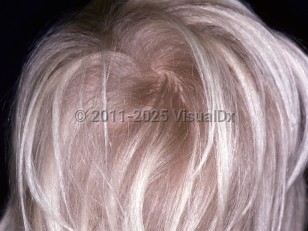Loose anagen syndrome - Hair and Scalp
Alerts and Notices
Important News & Links
Synopsis

Loose anagen syndrome is a childhood hair disorder characterized by easily and painlessly extractable anagen hairs. The exact etiology and pathogenesis are not known, although it is thought to result from poor adhesion between the cuticle of the hair shaft and the inner root sheath of anagen hairs. Both sporadic and familial forms (autosomal dominant with incomplete penetrance) have been described. Clinical presentation is heterogeneous and can include diffuse thinning of hair, difficult to manage or unruly hair, or normal-appearing hair with excessive shedding. Common complaints from parents regarding their child's hair are that the hair "has always been thin," "has not been growing," "has never been cut," "is difficult to manage," "constantly sheds," or "is easily pulled out." Eyebrows, eyelashes, and body hair are not involved, and there are no associated abnormalities of skin, nails, or teeth.
Loose anagen syndrome primarily affects young children with light-colored hair, especially blond and light brown, although individuals with dark-colored hair can also be affected, albeit much less commonly. There is a strong female preponderance and only whites are affected. Typical onset is during infancy and early childhood with the vast majority of cases developing within the first 3 years of life. Adults are rarely affected – those diagnosed are usually family members of affected children.
Children with loose anagen syndrome are otherwise healthy, and most cases will spontaneously improve by adulthood (and occasionally by adolescence). With advancing age, the hair will become longer, denser, and darker; however, it is important to note that loose anagen hairs will still be present, but to a lesser degree. Although no treatment is required, anecdotal evidence has indicated improvement with topical minoxidil therapy.
Loose anagen syndrome primarily affects young children with light-colored hair, especially blond and light brown, although individuals with dark-colored hair can also be affected, albeit much less commonly. There is a strong female preponderance and only whites are affected. Typical onset is during infancy and early childhood with the vast majority of cases developing within the first 3 years of life. Adults are rarely affected – those diagnosed are usually family members of affected children.
Children with loose anagen syndrome are otherwise healthy, and most cases will spontaneously improve by adulthood (and occasionally by adolescence). With advancing age, the hair will become longer, denser, and darker; however, it is important to note that loose anagen hairs will still be present, but to a lesser degree. Although no treatment is required, anecdotal evidence has indicated improvement with topical minoxidil therapy.
Codes
ICD10CM:
L67.8 – Other hair color and hair shaft abnormalities
SNOMEDCT:
238735005 – Loose anagen hair syndrome
L67.8 – Other hair color and hair shaft abnormalities
SNOMEDCT:
238735005 – Loose anagen hair syndrome
Look For
Subscription Required
Diagnostic Pearls
Subscription Required
Differential Diagnosis & Pitfalls

To perform a comparison, select diagnoses from the classic differential
Subscription Required
Best Tests
Subscription Required
Management Pearls
Subscription Required
Therapy
Subscription Required
References
Subscription Required
Last Updated:01/19/2022
Loose anagen syndrome - Hair and Scalp

